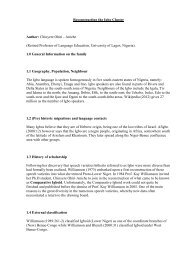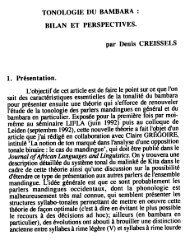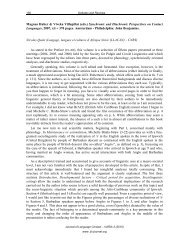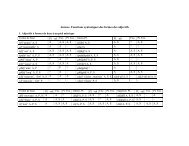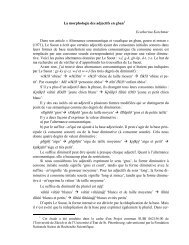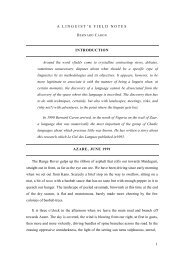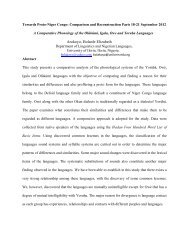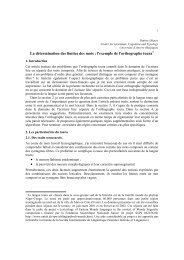Testing orthographies in the Nko and Roman scripts - Llacan
Testing orthographies in the Nko and Roman scripts - Llacan
Testing orthographies in the Nko and Roman scripts - Llacan
You also want an ePaper? Increase the reach of your titles
YUMPU automatically turns print PDFs into web optimized ePapers that Google loves.
<strong>Test<strong>in</strong>g</strong> <strong>orthographies</strong> <strong>in</strong> <strong>the</strong> <strong>Nko</strong> <strong>and</strong> <strong>Roman</strong> <strong>scripts</strong><br />
Analysis of overall performance<br />
The total results of read<strong>in</strong>g miscues for <strong>the</strong> <strong>Nko</strong> <strong>and</strong> <strong>Roman</strong> <strong>scripts</strong> are recorded<br />
<strong>in</strong> Table 2.<br />
All self-corrections imply repetition. In order to avoid <strong>the</strong> redundancy of mark<strong>in</strong>g<br />
repetition along with each self-correction, only those repetitions not followed by a<br />
self-correction of a morpheme with<strong>in</strong> its bounds are noted as repetition miscues. Such<br />
repetitions <strong>in</strong>dicate a block <strong>in</strong> <strong>the</strong> orthographical, phonological, mean<strong>in</strong>g (lexical), or<br />
contextual process<strong>in</strong>g (Marilyn Jager Adams <strong>in</strong> Mattews 1994:3). When a block (not<br />
an <strong>in</strong>correct attempt) occurs <strong>in</strong> process<strong>in</strong>g, <strong>the</strong> reader attempts to reprocess <strong>the</strong> new<br />
<strong>in</strong>formation at that location. After hav<strong>in</strong>g decoded <strong>the</strong> new <strong>in</strong>formation at <strong>the</strong> lexical<br />
mean<strong>in</strong>g level, it rema<strong>in</strong>s to process <strong>the</strong> mean<strong>in</strong>g of that lexeme <strong>in</strong> its context. So,<br />
typically, readers reread <strong>the</strong> preced<strong>in</strong>g word, phrase, or even clause to <strong>in</strong>corporate <strong>the</strong><br />
new <strong>in</strong>formation as it relates to its grammatical constituents. Repetition is <strong>the</strong> readers’<br />
attempt to preserve <strong>the</strong> cumulative comprehension of <strong>the</strong> text while experienc<strong>in</strong>g a<br />
block <strong>in</strong> <strong>in</strong>formation process<strong>in</strong>g. The read<strong>in</strong>g miscue results show that Man<strong>in</strong>ka<br />
readers of <strong>the</strong> <strong>Nko</strong> script experience considerably fewer process<strong>in</strong>g blocks than those<br />
read<strong>in</strong>g <strong>the</strong> <strong>Roman</strong> script.<br />
All self-corrections imply <strong>in</strong>correct attempts. But not all <strong>in</strong>correct attempts are<br />
self-corrected. In this analysis, every <strong>in</strong>correct attempt followed by a self-correction<br />
of that miscue was marked as a self-correction only. Redundancy <strong>in</strong> <strong>the</strong> data is thus<br />
avoided. A self-correction proves comprehension of <strong>the</strong> text <strong>in</strong> that location.<br />
Comprehension is more important for our purpose than read<strong>in</strong>g fluency <strong>and</strong> one does<br />
not always imply <strong>the</strong> o<strong>the</strong>r. A self-correction may occur when <strong>the</strong> context processor<br />
encounters a lexeme that was unexpected <strong>in</strong> that position. Some readers at this po<strong>in</strong>t<br />
may employ an addition or omission miscue. If, however, <strong>the</strong> reader halts <strong>and</strong><br />
reprocesses <strong>the</strong> <strong>in</strong>formation from <strong>the</strong> orthographical processor on up <strong>the</strong> process<strong>in</strong>g<br />
hierarchy <strong>and</strong> decodes <strong>the</strong> message correctly, <strong>the</strong> process<strong>in</strong>g block becomes a selfcorrection.<br />
Miscues are not all equal <strong>in</strong> value. From <strong>the</strong> perspective of<br />
communication, it is better for a reader to have a self-correction miscue <strong>and</strong> lose<br />
some fluency than an <strong>in</strong>correct attempt miscue. For <strong>in</strong>correct attempt miscues are<br />
never corrected <strong>and</strong> presumably, <strong>the</strong>refore, never correctly understood. The read<strong>in</strong>g<br />
miscue results show that <strong>Nko</strong> readers correct more of <strong>the</strong>ir <strong>in</strong>correct attempts than<br />
<strong>Roman</strong> script readers <strong>and</strong> consequently require more time.<br />
There are two typographical errors <strong>in</strong> <strong>the</strong> <strong>Roman</strong> script research text. One <strong>Roman</strong><br />
script reader actually corrected <strong>the</strong>se errors without <strong>the</strong> slightest pause <strong>in</strong> <strong>the</strong> read<strong>in</strong>g.<br />
The errors were word medial <strong>and</strong> it is doubtful that he even “saw” <strong>the</strong>m. The<br />
orthographical processor of this fluent reader took <strong>in</strong> <strong>the</strong> word image as a whole<br />
45


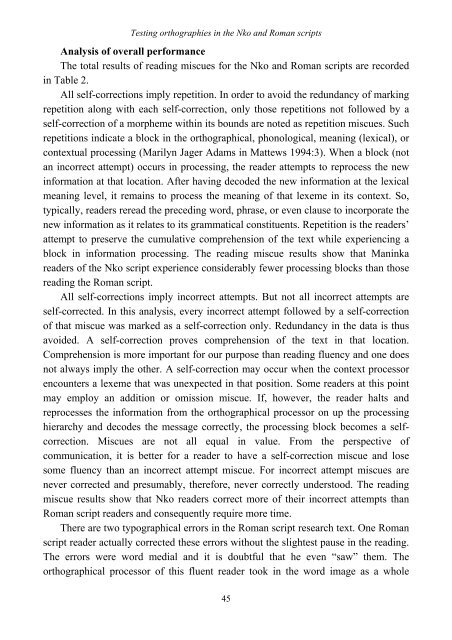
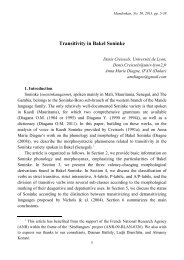
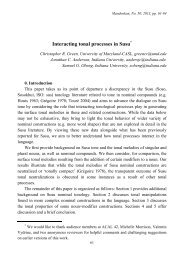
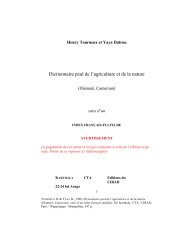
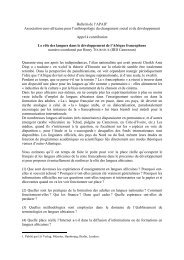

![[halshs-00645129, v1] Depressor consonants in Geji - Llacan - CNRS](https://img.yumpu.com/17832391/1/190x245/halshs-00645129-v1-depressor-consonants-in-geji-llacan-cnrs.jpg?quality=85)
